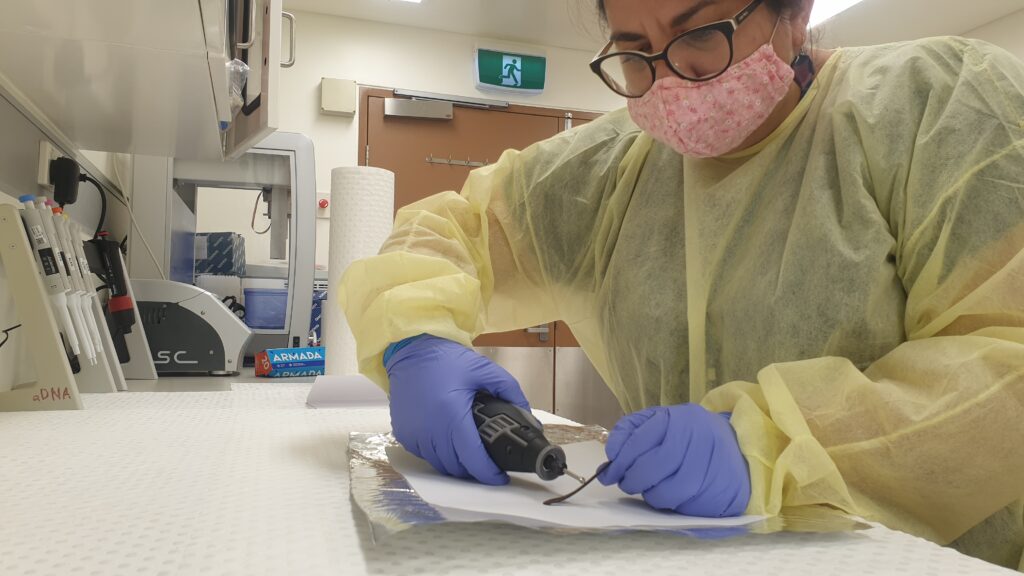ShellBank is an innovative traceability toolkit and a global database of marine turtle DNA. Launched in late 2022 after a successful pilot phase, it provides comprehensive genetic profiles from marine turtle populations worldwide, crucial for tracing the origins of turtles, turtle parts and products back to the turtle populations impacted by threats, such as overexploitation, bycatch, and trade. By extracting DNA from any turtle, turtle part or product, we can compare them against the genetic profiles in the ShellBank database. This enhances our ability to identify how turtles are connected, which populations are most at-risk and those that require greatest protection, informing conservation management and law enforcement, ultimately strengthening management measures to recover turtle populations.


Tissue and shell samples are taken from live or dead turtles, whether from conservation monitoring programs, bycaught, harvested, stranded, confiscated or seized, including parts or products.

DNA is extracted from collected samples.

DNA is amplified and sequenced from extracted sample.

The DNA sequence or “haplotype” of each sample tested is added to the ShellBank databases.

Identifies if there’s a new genetically distinct population (“genetic stock”). A match in the reference database helps determine likely population origin (or source).

The ShellBank database enables the identification of the most at-risk populations and those requiring greatest protection.
ShellBank uses DNA. Its ‘banks’ of data are a rapidly evolving global repository for marine turtle DNA. Comprising three main components (Nesting, In-Water and Trade) ShellBank stores and uses data from many international partnerships to enable effective traceability. It is constantly being updated and contributed to by many collaborators. Data, primarily mined from published material, is verified by the ShellBank team and stored in the database. It is open source for the reference data (Nesting and In-Water), and privacy-protected for the Trade data, bolstering accessibility to users around the world.
With a complete database, we can finally understand what genetically distinct turtle populations we have, how they are interconnected, and which populations are most at-risk, such as those being unsustainably harvested, traded or incidentally caught in fisheries. By comparing across databases it will be possible to accurately trace the population origin, enhance a country’s enforcement efforts against illegal activity, and advance marine turtle conservation at national, regional and global levels. ShellBank’s intent and purpose has been refined over time, with a clear vision for growth.
Containing genetic information from samples collected from wild nesting turtles, hatchlings or embryos / eggs used to assign genetic stock (nesting) origin.
Contains genetic information from samples collected in-water from wild turtles, including all size classes. These may include foraging, stranded, or bycatch animals (both alive and dead) used to assign genetic stock population boundaries and connectivity.
Contains genetic information from samples collected from confiscated marine turtles and marine turtle parts or products. These samples may be taken from live animals, meat, eggs, whole stuffed animals or shells, or tortoiseshell products (i.e., raw scutes or highly processed items such as jewellery) to record which genetic stock was traded at what entry point.

Confiscation Database
Rookery Baseline Database
In Water Database
Likely poached location
ShellBank is the world’s first traceability toolkit and global database of marine turtle DNA, a game changer in the effort to protect marine turtles from unsustainable use, illegal trade and bycatch.
Six of seven marine turtle species are listed from Vulnerable to Critically Endangered (IUCN Red List). Many factors contribute to this decline, but a significant concern is the ongoing legal and illegal unsustainable take, bycatch and trade. Over the last 30 years, more than 1.1 million marine turtles have been illegally exploited. However, it remains unclear where this exploitation is occurring, where it is most prevalent today, and which populations are being targeted. ShellBank addresses this critical data gap, offering targeted, effective conservation interventions that will benefit not only turtles but also the people who depend on them.
Our goal is that by 2030, ShellBank will be enacted in at least 15 countries globally to trace, track and detect marine turtle populations most at-risk, so that targeted efforts are able to better enforce and protect them, turtle populations can rebound and communities benefit.
We will do this by enhancing marine turtle genetic traceability and data sharing to:
ShellBank consists of a raft of tools, offering:
ShellBank was created in 2018. It first showcased DNA shell extraction results in 2019, then piloted a project in Australia. Initially conceived to help fight against the illegal turtle trade, ShellBank has evolved to serve as an invaluable tool for addressing other threats such as bycatch and overexploitation. ShellBank is a game-changing tool to help protect turtles extinction, and we are now ready to move from pilot to into practice.
Initiated by WWF, ShellBank is a global, multi-partner initiative. Collaboration is key to its success, with institutions, organizations and individuals from across the globe involved in building the ShellBank database and using its supporting tools.
ShellBank is intended to be open-source, however the information contained is not easily interpreted by the general public. If you need support in accessing and using our database, please reach out to us.